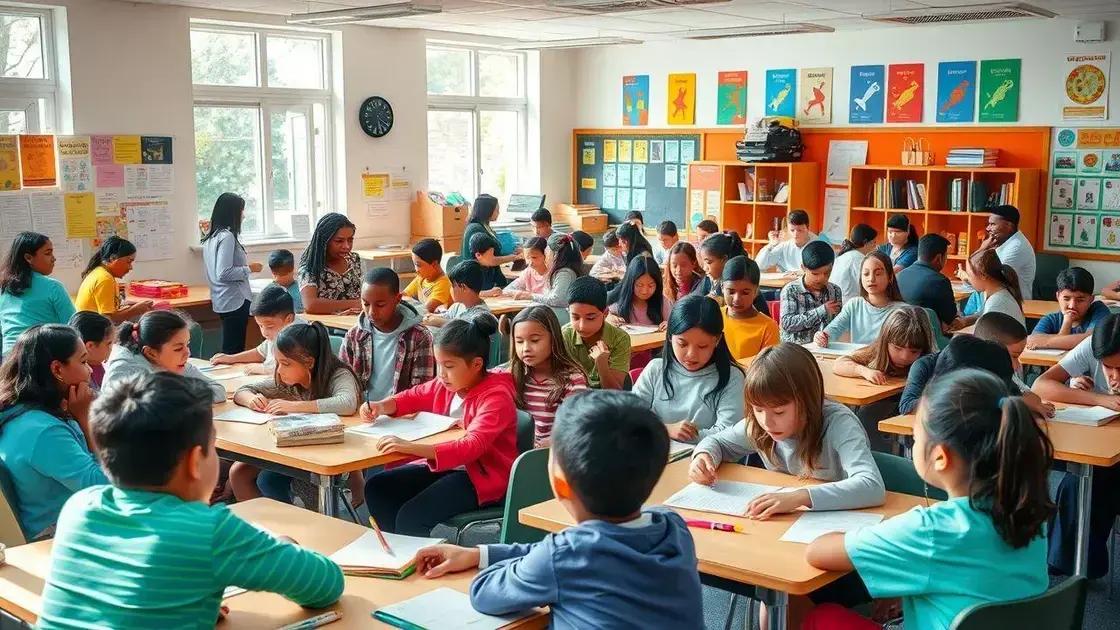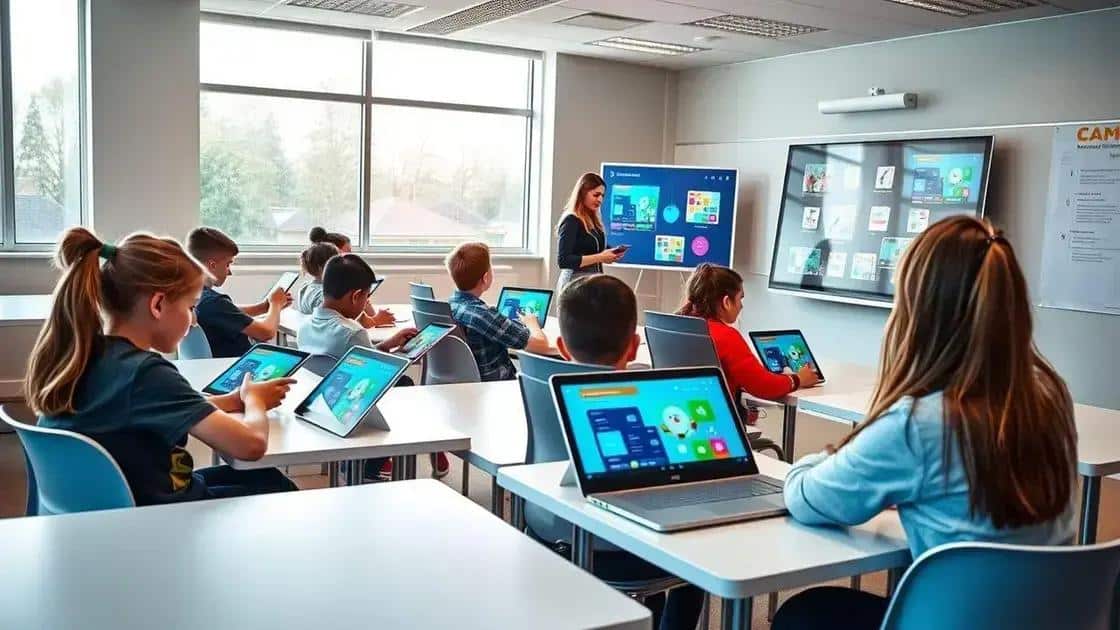Then curriculum improvement ideas to enhance student learning

Measuring the impact of curriculum changes involves using assessments, gathering feedback from students and parents, and analyzing performance data to ensure effective educational strategies and continuous improvement.
Then curriculum improvement ideas can transform how students learn and engage in the classroom. Have you ever considered how a few adjustments might enrich your teaching approach? Let’s dive into innovative strategies that can make a difference!
Understanding the importance of curriculum improvement
Understanding the importance of curriculum improvement is crucial for fostering effective learning environments. A well-structured curriculum not only engages students but also accommodates their diverse needs.
Why Curriculum Improvement Matters
Improving the curriculum allows teachers to enhance their teaching methods, which directly impacts student performance. It ensures that educational content remains relevant and aligned with current standards and practices.
- Engages students more effectively.
- Addresses diverse learning styles.
- Encourages critical thinking and problem-solving skills.
Curriculum improvement involves continuous evaluation and adjustment. This process involves gathering feedback from students and educators to identify gaps in learning. By incorporating new teaching strategies, schools can support a range of learning experiences.
Fostering a Positive Learning Environment
Creating a positive learning environment is a key factor in student success. Improved curricula can promote collaboration and interaction among peers, enhancing the overall educational experience. When students are encouraged to participate actively, they are more likely to take ownership of their learning.
- Utilizes technology for interactive lessons.
- Promotes group projects and discussions.
- Integrates real-world applications in lessons.
Ultimately, the focused efforts on curriculum improvement lead to better preparedness for future challenges in academics and beyond. By understanding its importance, educators can make informed decisions that benefit both students and the educational system as a whole.
Key strategies for effective curriculum enhancement
Key strategies for effective curriculum enhancement are essential for improving student learning outcomes. By adopting focused approaches, educators can create a dynamic learning environment that caters to all students.
Incorporating Collaboration
One effective strategy is to promote collaboration among teachers. When educators share their experiences and teaching methods, they can develop a more cohesive curriculum. This collaborative approach allows for cross-curricular connections that enrich student learning.
- Facilitate regular teacher meetings.
- Encourage sharing of best practices.
- Develop joint projects across subjects.
Another strategy involves integrating technology into the curriculum. By using digital tools and resources, students can engage more actively in their learning. This integration not only makes lessons more interactive but also prepares students for a tech-driven world.
Flexible Learning Pathways
Offering flexible learning pathways is crucial. Schools should allow students to choose projects and subjects that align with their interests. This choice fosters motivation and enhances the learning experience.
- Implement elective courses that spark interest.
- Allow project-based learning opportunities.
- Encourage student voice in curriculum decisions.
Lastly, continuous assessment and feedback are vital for effective curriculum enhancement. By regularly evaluating the curriculum and gathering feedback from students, teachers can identify areas that need improvement.
Regular check-ins help in adapting the curriculum to better suit student needs. Creating an inclusive curriculum involves reflecting on these strategies and making necessary adjustments to enhance educational outcomes.
Incorporating technology into curriculum design

Incorporating technology into curriculum design significantly enhances the learning experience for students. When effectively integrated, technology can support various teaching methods and cater to different learning styles.
Benefits of Technology Integration
The integration of technology provides several benefits to both students and educators. One major advantage is the increased access to a wide range of resources. With the internet, students can explore topics in-depth and engage with interactive content.
- Access to multimedia resources enhances understanding.
- Online collaboration tools encourage teamwork.
- Learning management systems streamline communication.
Moreover, using technology allows for personalized learning experiences. Students can work at their own pace and receive immediate feedback, which supports mastery of the subject matter. This adaptability ensures that each student can thrive in their educational journey.
Practical Applications of Technology
Implementing technology can take various forms in the classroom. For instance, teachers can utilize educational apps to create engaging lessons. These tools can gamify learning, making complex subjects more approachable and fun for students.
- Incorporating virtual simulations for hands-on learning.
- Encouraging the use of digital portfolios for student work.
- Utilizing online quizzes to assess understanding instantly.
Additionally, technology fosters open communication between teachers and students. Platforms like Google Classroom or Microsoft Teams help keep everyone informed and connected, promoting a collaborative learning environment.
As we embrace these technology trends, it’s essential that teachers receive proper training. Educators should feel confident in utilizing these tools to enrich their teaching and enhance student engagement.
Engaging students through diverse learning methods
Engaging students through diverse learning methods is essential for fostering a dynamic classroom environment. By recognizing that each student learns differently, educators can create strategies that resonate with various learning styles.
Understanding Learning Styles
Students have unique preferences that affect how they assimilate information. Some may excel in visual learning, while others prefer auditory or kinesthetic approaches. By catering to these differences, teachers can enhance student engagement.
- Visual learners benefit from diagrams and videos.
- Auditory learners thrive with discussions and lectures.
- Kinesthetic learners engage best through hands-on activities.
Moreover, combining different methods helps to reach all types of learners simultaneously. When lessons incorporate interactive elements, students are more likely to connect with the material.
Strategies for Engagement
Several effective strategies can be implemented to engage students more actively. Project-based learning is a fantastic way to allow students to explore topics in-depth. It fosters collaboration and critical thinking, as they work together toward a common goal.
- Use group projects to encourage teamwork.
- Integrate real-world challenges that relate to their studies.
- Encourage students to present their findings creatively.
Incorporating technology also plays a significant role in engaging students. Online discussions, interactive quizzes, and educational games can make lessons more enjoyable and formative. When students use technology, they become active participants in their learning journey.
Furthermore, allowing choice in assignments lets students express their creativity. By providing options, you empower them to explore their interests while meeting learning objectives. This freedom not only increases motivation but also promotes deeper understanding of the material.
Measuring the impact of curriculum changes
Measuring the impact of curriculum changes is crucial for understanding how effectively educational strategies enhance student learning. By evaluating these changes, schools can determine which methods work best and where improvements can be made.
Data Collection Methods
One method of measuring impact is through standardized assessments. These assessments provide a clear picture of student performance over time. By comparing test scores before and after implementing curriculum changes, educators can analyze trends and identify areas of growth.
- Use formative assessments to gauge everyday understanding.
- Incorporate summative assessments for end-of-unit evaluations.
- Collect qualitative feedback from students and teachers.
Another effective method is through surveys. Gathering input from students, parents, and teachers can reveal insights on how curriculum changes affect engagement and satisfaction. This feedback helps identify strengths and weaknesses in the curriculum.
Analyzing the Results
Once data is collected, it is essential to analyze the results thoroughly. Educators should look for patterns within the data that indicate the effectiveness of the curriculum. For instance, improved test scores may suggest successful teaching strategies or areas where students thrive.
- Identify subject areas with significant improvement.
- Evaluate changes in student attendance and participation.
- Consider the long-term effects on student retention rates.
It’s also beneficial to conduct follow-up studies to track students’ progress over time. Longitudinal studies provide a deeper understanding of how sustained curriculum changes influence learning outcomes.
Additionally, fostering an environment of continuous improvement is important. Schools should be open to adjusting the curriculum based on findings. This adaptive approach ensures that the curriculum remains relevant and effective for all students.
Measuring the impact of curriculum changes is vital for improving educational practices. By utilizing various methods such as assessments, surveys, and data analysis, educators can gain valuable insights into the effectiveness of their curriculum. Engaging students through diverse learning methods and continuously adapting the curriculum ensures that all students can succeed. Embracing a culture of growth and feedback will help schools create a thriving learning environment. Ultimately, the goal is to foster an enriching experience that empowers every student to reach their full potential.
FAQ – Frequently Asked Questions about Curriculum Changes
How can I measure the impact of curriculum changes?
You can measure the impact by using standardized assessments, gathering feedback through surveys, and analyzing student performance data over time.
What role do assessments play in evaluating curriculum effectiveness?
Assessments provide measurable data on student learning outcomes, helping educators identify strengths and areas that need improvement.
Why is feedback from students and parents important?
Feedback is crucial for understanding the effectiveness of the curriculum and ensuring it meets the needs and preferences of all stakeholders.
How can I ensure continuous improvement in my curriculum?
By regularly reviewing assessment results, collecting feedback, and being open to making changes, you can create a responsive and effective curriculum.






